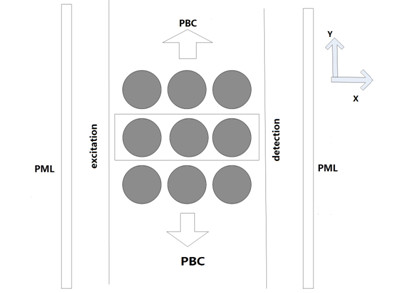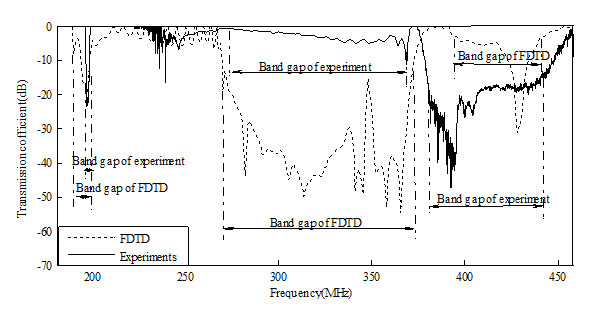Phononic crystals are periodic elastic structures with arrays of scattering inclusions located in a homogeneous host material. Phononic crystals are widely used in radio frequency (RF, MHz-GHz) devices, such as surface acoustic wave filter and bulk acoustic wave filter, which are called one-dimensional phononic crystals.
Recently, two-dimensional (2D) piezoelectric phononic crystals have more attractive features such as multi-forbidden bands, high reflection and localized state control, ultra broadband, negative refraction and low loss and acoustic focus, showing good prospect in application of 2D acoustic functional devices.
There are methods to analyze surface acoustic waves propagation in 2D piezoelectric phononic crystals. They are plane wave expansion, finite element method and finite different time domain. Compared with plane wave expansion and finite element method, the finite different time domain method has been demonstrated to be both simple and efficient for analyzing phononic crystals in Hz and KHz frequency range.
However, finite different time domain analysis of phononic crystals in radio frequency (RF, MHz-GHz) range is still in the exploratory stage.
In order to analyze the propagation of surface acoustic waves in the 2D piezoelectric phononic crystals in radio frequency range, researchers from the Institute of Acoustics of the Chinese Academy of Sciences have presented the finite different time domain theoretical model.
In the model as displayed in Fig.1, piezoelectric effect was taken into account in the finite different time domain differential equations.

Fig.1 The finite different time domain model of the 2D piezoelectric phononic crystals (Image by TIAN)
To reduce the memory and time cost, periodic boundary condition was used to simulate infinite periodic structure of piezoelectric phononic crystals in the Y direction. While in the X direction, the phononic crystals were finite, and excitation signal source and signal receiver were placed on the two sides respectively.
To attenuate the artificial reflection of both sides in the X direction, perfect matching layer boundary conditions were used to achieve the complete absorption of surface acoustic waves. By comparing the excited and received signal spectral, the transmission coefficients of the piezoelectric phononic crystals in the X direction was achieved, and then the band gaps were obtained.
In order to test and validity of the finite different time domain model, experiments were designed to measure the band gaps of phononic crystals with network analyzer.

Fig.2 Transmission coefficients in the X direction of piezoelectric phononic crystals (Image by TIAN)
Fig.2 denoted the transmission coefficients of the piezoelectric phononic crystals in the X direction obtained by experiments and finite different time domain calculation respectively.
From Fig.2, it could be seen three close band gaps obtained by finite different time domain were close to the experiment. It indicated that the finite different time domain calculation was efficient.
This new model had been proved accurate and efficient to analyze 2D surface acoustic wave piezoelectric phononic crystals at radio frequency. Further research should be done to take the mass-loading into account with three dimensional model.
Funding for this research came from the National Natural Science Foundation of China (11174318, 11304346, 61106081), the Chinese Postdoctoral Science Foundation (2011M501204, 2013T60718), the National High Technology Research and Development Program (863 Program) (SS2013AA041103), the Beijing Municipal Science and Technology Commission Project (Z141100003814016) and the Fundamental Research Funds for the Central Universities (HUST:No.2013QN038).
Reference:
TIAN Yahui, LI Honglang, KE Yabing, LUO Wei, WEI Jiangbo and HE Shitang. Finite Difference Time Domain Analysis of Two-Dimensional Surface Acoustic Wave Piezoelectric Phononic Crystals at Radio Frequency. Chinese Journal of Acoustics (Vol. 34, No. 3, pp. 257-266, 2015). DOI: 10.15949/j.cnki.0217-9776.2015.03.006
Contact:
TIAN Yahui
Institute of Acoustics, Chinese Academy of Sciences, Beijing 100190, China
Email: tianyahui@mail.ioa.ac.cn or yahuitian@yeah.net


